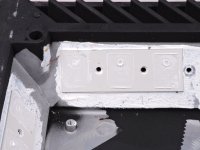I have noticed that some amplifiers have thermal paste applied down the entire length of the heat sink.
When reapplying thermal compound after working on an amp is there any benefit to putting it back like original (all the way down the sink), or is it okay to put only under the components 'in contact' with the sink when reassembling?
When reapplying thermal compound after working on an amp is there any benefit to putting it back like original (all the way down the sink), or is it okay to put only under the components 'in contact' with the sink when reassembling?
It makes no difference in the reliability of the amp. It's likely quicker for them to paint the entire length than applying to individual locations or to the transistors.
The only benefit that I've seen is that it will catch and hold tiny wire strands which can cause the amp to fail. You don't hear about wire strands much in the amps here but I had a LOT of amps with strands in them.
The only benefit that I've seen is that it will catch and hold tiny wire strands which can cause the amp to fail. You don't hear about wire strands much in the amps here but I had a LOT of amps with strands in them.
Good point! I didn't think about it possibly catching debris.
My thoughts were centered around the fact that a 5 oz. tube of DC 340 is $63.00 on Am*@on right know. Arrghhhh!
I agree, I bet ~ 50% of the amplifiers I have opened up for the first time, I have found at least 1 wire strand somewhere in it.
The current one I'm working on had several pcs floating around inside.
My thoughts were centered around the fact that a 5 oz. tube of DC 340 is $63.00 on Am*@on right know. Arrghhhh!
I agree, I bet ~ 50% of the amplifiers I have opened up for the first time, I have found at least 1 wire strand somewhere in it.
The current one I'm working on had several pcs floating around inside.
The manufacturers probably have a nasty paint brush poked into a can of thermal compound to slather on all those heat sinks - messy, to say the least. The stuff seems to have an affinity for dark clothing.
Haha, For me it seems to have an affinity for everything!The stuff seems to have an affinity for dark clothing.
Thermal goop is indeed remarkably messy. You only need enough to fill any voids between the device and the heat sink. Thermal grease is not very thermally conductive but it is more thermally conductive than air.
Tom
Tom
If I were to see that many wire 'hairs' stuck to the thermal compound, I would immediately blame the last tech to work on it! Funny that there hasn't already been trouble.
As for the amount compound needed, it is likely a bit less than you think, and if 'extra' is squishing out of the sides when the transistor is tightened down well that is just waste.
As for the amount compound needed, it is likely a bit less than you think, and if 'extra' is squishing out of the sides when the transistor is tightened down well that is just waste.
"Haha, For me it seems to have an affinity for everything!"
Is it so bad that you even find it in your Never-Seez?
"I would immediately blame the last tech to work on it!"
When people stripped wires over the amp, the gaps around the edges of the cover would allow them to get into the amp.
Is it so bad that you even find it in your Never-Seez?
"I would immediately blame the last tech to work on it!"
When people stripped wires over the amp, the gaps around the edges of the cover would allow them to get into the amp.
That is exactly right. I've got white finger prints all over the bench and silver ones all over the car.Is it so bad that you even find it in your Never-Seez?
What I like to do for an even and not excessive layer of thermal compound is to take a round toothpick, dip in the compound, and roll it on - you get a nice, even coat that way, with not a lot of excess goo.
Of course, when I'm feeling lazy, I poot out a little thermal goop on my fingertip and smear it on manually - it's not to hard to control the amount that gets applied.
- Home
- General Interest
- Car Audio
- Applying Thermal Compound

